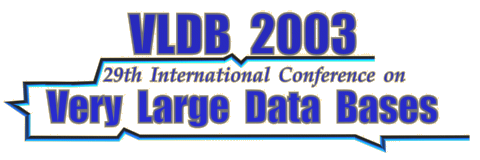|
|
|
Collection of Classical Antiquities
The Collection of Classical Antiquities contains Greek and Roman works including not only architectural remains, sculptures and vases, inscriptions and mosaics but also bronzes and jewellery. It is on display in two locations: the Pergamon Museum and the main floor of the Altes Museum.
|
The collection
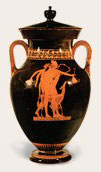 With an annual figure of 850,000 visitors the Pergamon Museum ranks among the most popular buildings of the state museums. Its main attraction is the Pergamon Altar (2nd century BC). The frieze depicting the battle between the Gods and Gaints is regarded as a masterpiece of Hellenistic art. The next room to the south contains the market Gate of Miletus, an outstanding example of Roman architecture.From there visitors can proceed to the Museum of Ancient Near Eastern Art.
With an annual figure of 850,000 visitors the Pergamon Museum ranks among the most popular buildings of the state museums. Its main attraction is the Pergamon Altar (2nd century BC). The frieze depicting the battle between the Gods and Gaints is regarded as a masterpiece of Hellenistic art. The next room to the south contains the market Gate of Miletus, an outstanding example of Roman architecture.From there visitors can proceed to the Museum of Ancient Near Eastern Art.
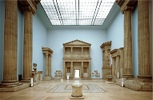 Examples of Greek architecture are presented in the hall of Hellenistic architecture adjoining the great hall to the north. The northern wing of the Pergamon Museum contains classical sculptures from the Archaic age to the Hellenistic period, ancient copies of Greek originals as well as Roman art.
Examples of Greek architecture are presented in the hall of Hellenistic architecture adjoining the great hall to the north. The northern wing of the Pergamon Museum contains classical sculptures from the Archaic age to the Hellenistic period, ancient copies of Greek originals as well as Roman art.
|
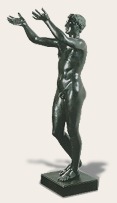 Greek and Roman art and sculptures can be found in the Altes Museum. The main highlights, the art of the Etruscans, will go on show when major restoration work on the building has been completed. Until then an exhibition of Greek works of art is open to the public on the newly designed main floor of the building. This thematically arranged exhibition includes stone sculptures, clay and bronze figures, friezes, vases, gold jewellery and silverware. Three information displays provide details on additional topics such as Greek myths, ancient city culture and the archaeological sites investigated by the Berlin museums.
Greek and Roman art and sculptures can be found in the Altes Museum. The main highlights, the art of the Etruscans, will go on show when major restoration work on the building has been completed. Until then an exhibition of Greek works of art is open to the public on the newly designed main floor of the building. This thematically arranged exhibition includes stone sculptures, clay and bronze figures, friezes, vases, gold jewellery and silverware. Three information displays provide details on additional topics such as Greek myths, ancient city culture and the archaeological sites investigated by the Berlin museums.
Roman Art is represented by relatively few pieces such as portraits of Caesar and Cleopatra, sarcophagi, mosaics, frescos and Roman-Egyptian mummy portraits offering a taste of the final presentation.
Plaster models of antique art are on display in the Replica Collection in Berlin-Charlottenburg near the Egyptian Museum. In the nearby Replica Workshop replicas are available for purchase.
|
|
Museum of Islamic Art
The museum is situated in the south wing of the Pergamon Museum. Its newly arranged permanent exhibition is dedicated to the art of Islamic peoples from the eighth to the nineteenth century. The works of art originate from the vast area stretching from Spain to India. The collection's main focus is on the Middle East including Egypt and Iran.
|
The collection
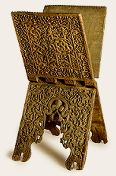 The broad spectrum of the collection includes architectural decorations, applied arts and crafts, jewellry, and rare illuminated and calligraphed manuscripts. The architectural decorations represent one of the major attractions, conveying also typical concepts of space and environments in various media: stone (the fašade from Mshatta), stuccoes (archaeological finds from Samarra), painted wooden panelling (Aleppo Room) and wall ceramics in various techniques (prayer niches from Kashan and Konya).
The broad spectrum of the collection includes architectural decorations, applied arts and crafts, jewellry, and rare illuminated and calligraphed manuscripts. The architectural decorations represent one of the major attractions, conveying also typical concepts of space and environments in various media: stone (the fašade from Mshatta), stuccoes (archaeological finds from Samarra), painted wooden panelling (Aleppo Room) and wall ceramics in various techniques (prayer niches from Kashan and Konya).
 The applied arts include works in all possible materials: ceramic vessels, metalwork, carvings in wood and bone, glasses, textiles, carpets. Within the area of books and ancient writings, the calligraphic works and miniatures from albums of Mogul times are of particular significance.
The applied arts include works in all possible materials: ceramic vessels, metalwork, carvings in wood and bone, glasses, textiles, carpets. Within the area of books and ancient writings, the calligraphic works and miniatures from albums of Mogul times are of particular significance.
|
|
Museum of Ancient Near Eastern Art
The Museum of Western Asiatic Antiquities ranks alongside the Louvre and the British Museum as one of the world's leading museums of ancient oriental treasures. Shown in an area covering 2,000 square metres the exhibits convey an impression of six thousand years of history, culture and art in the ancient Near East.
|
The collection
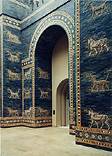 Fourteen rooms are devoted to this collection in the southern wing of the Pergamon Museum. The collection contains many important examples of architecture, reliefs and smaller objects. Some are of great world significance and were once excavated by German archaeologists. They originate from the Sumerian, Babylonian, Assyrian and northern Syrian/eastern Anatolian regions which today include Iraq, Syria, and Turkey.
Fourteen rooms are devoted to this collection in the southern wing of the Pergamon Museum. The collection contains many important examples of architecture, reliefs and smaller objects. Some are of great world significance and were once excavated by German archaeologists. They originate from the Sumerian, Babylonian, Assyrian and northern Syrian/eastern Anatolian regions which today include Iraq, Syria, and Turkey.
Finds from Uruk offer insights into the beginnings of writing during the fourth century BC as well as into Sumerian art and culture. Clay tablets and seals provide evidence of the early use of writing throughout the whole of the ancient Near Eastern region.
|
|
 One of the major attractions lies along the main axis of this section of the museum. Here visitors can walk through and wonder at the world-famous reconstructions of brilliantly coloured Babylonian monuments: the Processional Way, the Ishtar Gate and the facade of the throne hall of King Nebuchadnezzar II (604 - 562 BC). Sections of the buildings were re-created to approximately the original dimensions by meticulously re- assembling the many broken pieces of excavated glazed bricks. Along the walls depictions of lions, bulls and dragons symbolize the major gods of Babylon.
One of the major attractions lies along the main axis of this section of the museum. Here visitors can walk through and wonder at the world-famous reconstructions of brilliantly coloured Babylonian monuments: the Processional Way, the Ishtar Gate and the facade of the throne hall of King Nebuchadnezzar II (604 - 562 BC). Sections of the buildings were re-created to approximately the original dimensions by meticulously re- assembling the many broken pieces of excavated glazed bricks. Along the walls depictions of lions, bulls and dragons symbolize the major gods of Babylon.
|
 The main attractions in the Babylonian Hall include the model of the Tower of Babel which was dedicated to Marduk, the chief god of the city, and a copy of the famous stela bearing the laws of King Hammurabi.
The main attractions in the Babylonian Hall include the model of the Tower of Babel which was dedicated to Marduk, the chief god of the city, and a copy of the famous stela bearing the laws of King Hammurabi.
Other outstanding works of ancient Near Eastern monumental architecture of the third and second century BC include reconstructed sections of temple facades from Uruk. One of the facades is decorated with coloured clay inlays while the other is characterized by its stunning brickwork reliefs.
The Assyrian palace reliefs from Kalchu, the one-time capital city, date from the ninth century BC The entrance to the reconstructed Neo-Assyrian palace hall is dominated by replicas of the colossal gatekeeping statues of mythical beasts. The artistic and crafting skills of the Assyrians during the first and second century BC are illustrated by vases, jewellery, tools, clay and stone reliefs, tiles and small sculptures made from a variety of materials.
|
|
|
